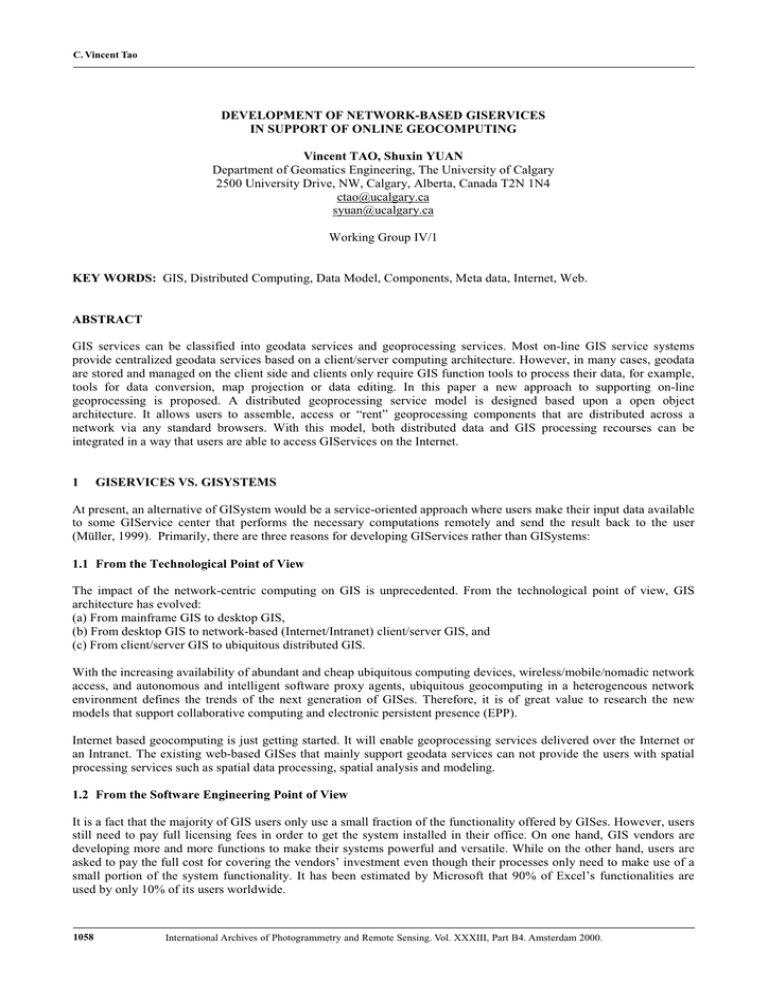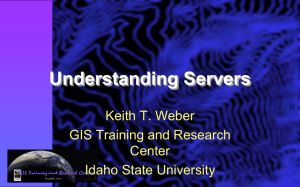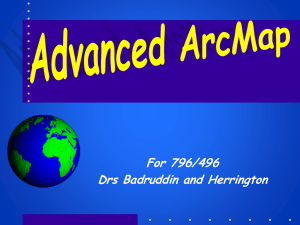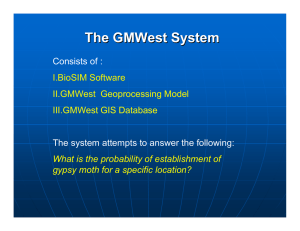DEVELOPMENT OF NETWORK-BASED GISERVICES IN SUPPORT OF ONLINE GEOCOMPUTING
advertisement

C. Vincent Tao DEVELOPMENT OF NETWORK-BASED GISERVICES IN SUPPORT OF ONLINE GEOCOMPUTING Vincent TAO, Shuxin YUAN Department of Geomatics Engineering, The University of Calgary 2500 University Drive, NW, Calgary, Alberta, Canada T2N 1N4 ctao@ucalgary.ca syuan@ucalgary.ca Working Group IV/1 KEY WORDS: GIS, Distributed Computing, Data Model, Components, Meta data, Internet, Web. ABSTRACT GIS services can be classified into geodata services and geoprocessing services. Most on-line GIS service systems provide centralized geodata services based on a client/server computing architecture. However, in many cases, geodata are stored and managed on the client side and clients only require GIS function tools to process their data, for example, tools for data conversion, map projection or data editing. In this paper a new approach to supporting on-line geoprocessing is proposed. A distributed geoprocessing service model is designed based upon a open object architecture. It allows users to assemble, access or “rent” geoprocessing components that are distributed across a network via any standard browsers. With this model, both distributed data and GIS processing recourses can be integrated in a way that users are able to access GIServices on the Internet. 1 GISERVICES VS. GISYSTEMS At present, an alternative of GISystem would be a service-oriented approach where users make their input data available to some GIService center that performs the necessary computations remotely and send the result back to the user (Müller, 1999). Primarily, there are three reasons for developing GIServices rather than GISystems: 1.1 From the Technological Point of View The impact of the network-centric computing on GIS is unprecedented. From the technological point of view, GIS architecture has evolved: (a) From mainframe GIS to desktop GIS, (b) From desktop GIS to network-based (Internet/Intranet) client/server GIS, and (c) From client/server GIS to ubiquitous distributed GIS. With the increasing availability of abundant and cheap ubiquitous computing devices, wireless/mobile/nomadic network access, and autonomous and intelligent software proxy agents, ubiquitous geocomputing in a heterogeneous network environment defines the trends of the next generation of GISes. Therefore, it is of great value to research the new models that support collaborative computing and electronic persistent presence (EPP). Internet based geocomputing is just getting started. It will enable geoprocessing services delivered over the Internet or an Intranet. The existing web-based GISes that mainly support geodata services can not provide the users with spatial processing services such as spatial data processing, spatial analysis and modeling. 1.2 From the Software Engineering Point of View It is a fact that the majority of GIS users only use a small fraction of the functionality offered by GISes. However, users still need to pay full licensing fees in order to get the system installed in their office. On one hand, GIS vendors are developing more and more functions to make their systems powerful and versatile. While on the other hand, users are asked to pay the full cost for covering the vendors’ investment even though their processes only need to make use of a small portion of the system functionality. It has been estimated by Microsoft that 90% of Excel’s functionalities are used by only 10% of its users worldwide. 1058 International Archives of Photogrammetry and Remote Sensing. Vol. XXXIII, Part B4. Amsterdam 2000. C. Vincent Tao With regards to the GIS community, it is even worse due to the high price of the software licensing as well as the considerable cost of GIS training and software maintenance. It is also very common, in reality, that if one software package does not work well for one function, another software package needs to be purchased to complete a job adequately. This is understandable, since one shoes can not fit all size. Each vendor has its own strength and targeted applications, and therefore, can not always work well in all GIS arenas. By looking at this business model, one may ask whether there is a way of changing this situation where the cost of purchasing software by the GIS community is substantial as is the investment by vendors to create packages that attempt to solve all problems. With the advent of software component technology, it is possible that a large proprietary GIS can be broken into many interoperable functional components. These components can be assembled and integrated by users to meet their own requirements. The key concept of Web-based GIServices is that the multi-function software offered by a traditional GIS vendor can be delivered through the assemblage of many interoperable geoprocessing components over a network. 1.3 From the Users’ Point of View With the geoprocessing services available on the Internet, users are able to choose and use the geoprocessing components based on their own needs. The software tools can be “rented” easily through the Web. This will also allow the user to build a customized system by assembling only the necessary components. Various e-commerce arrangements such as registration for access, software metering, etc. can be used. On one hand, this benefits the users in term of cost savings (paying per needs), and on the other hand, it will generate more profits to the vendors due to the massive access and purchase of services as well as the reduced overheads with respect to maintenance and customer support. A simple case of the use of these geoprocessing services is the manipulation of data sets that are located at a clients site. If the user needs a geoprocessing tool, for instance, a data conversion tool, to process the data, then there is no reason for the user to purchase a full license for a GIS package since the user only needs a few modules of the complete system. Utilizing an online geoprocessing services system, the user could login to the URL and “rent” the related modules to process the data and then store the results locally. 2 SYSTEM ARCHITECTURES FOR GISERVICES The technological basis for the development of GIS service systems is the networked communication infrastructure, as well as distributed object computing technologies. The general architecture of a GIS service system is illustrated in Figure 1. From the client/server computing point of view, there are three approaches to develop geoprocessing services. 2.1 Thin Client Architecture The client site only provides a user interface that allows the user to send a service request. All the computing work is done on servers elsewhere in the network. This model supports various “network” devices, such as desktop PCs, laptops, palmtops, PDAs (personal digital assistants), cell–phones and other information appliances. This architecture suits applications where the working environment is mobile, the communication methods are mainly wireless or require relatively narrow bandwidth. 2.2 Thick Client Architecture The client site becomes the primary resource for computing, but the geoprocessing components come from servers elsewhere in the network. The client site provides a workplace that supports local processing of data sets. This architecture works particularly well in an environment where data sets are mainly stored at the local site. Due to the fact that the size of spatial data sets is normally high, it is not efficient for the data to be transferred to the server for processing. Therefore, PDAs PCs Laptops Palmtops Application Client (AC) Service Request Distributed Computing Environment (DCE) Service Response Application Server (AS) Spatial and Aspatial Data Cataloging Specific and Common Object Registration Figure 1. A DCE-based architecture for GIServices International Archives of Photogrammetry and Remote Sensing. Vol. XXXIII, Part B4. Amsterdam 2000. 1059 C. Vincent Tao transferring functions to the local site for processing local data would have a clear advantage. 2.3 Smart Client Architecture With the advent of the distributed object computing technology, an optimized configuration of computing resources can be achieved. This results in a balanced thin/thick client or smart client architecture. In this architecture, the role of a client or a server is changeable. A client can be a server and a server can become a client. Depending on the bandwidth as well as the location of the data to be processed, the geoprocessing components can be assembled either on the client side or on the server side. Computing can be performed on both sides in a collaborative manner. This is an advanced distributed computing architecture that requires a more careful design. 3 GEOPROCESSING DATA MODELS FOR GISERVICES In a distributed environment, the geodata objects will provide clients and servers with the basic understanding of the geodata during the communication, as the geo-objects are passed in the network as parameters. The following conceptual data model defines the basic geospatial types and their relationships, as illustrated in figure 2. * Attribute Record link-to 1 have match * 1 Geo-Object have Layer 1 Geometry 1..* form 1..* 1 1..* 1 # 1 contain 1..* contain Map 1 Id 1 Type Name # * link-to 1 1 Remote Object url # Id 1 MetaData Entity Georeference System !describe Remote Methods attach-to Figure 2. A partial abstract geospatial data model for the prototype distributed GIS In this model, a Map/Layer/Geo-Object structure is used and basic geodata types are defined, such as geospatial geometry objects (Point, Polyline, Polygon, etc.), geospatial reference system objects (Datum, Ellipsoid, Projection, etc.), Metadata entities (Accuracy, etc.), and so on. A Geo-Object type is defined to integrate the geometry and the corresponding attribute records into single geospatial objects, such as a river which contains many sub-rivers or a city that may contain a lot of sub-objects. The geospatial reference system is applied to Map only since layers in one map usually have a unified reference system. Both Map and Layer objects may have Metadata entities to describe the data quality and other meta information of the map or layers. Unlike a desktop GIS data model, remote objects are included in the data model in order to support remote communications. Remote objects that link to the internal geo-objects (such as Map or Layer) provide remote methods to clients. The dotted lines that link to the remote object in Figure 2 are only examples of the relationships between remote objects and internal objects. In fact, any internal object may connect to the remote objects if the remote methods are required. Spatial data models define the way that the spatial data is organized and manipulated. There are many GIS data models in use, among which the geometry-centric geo-relational GIS model is the most popular one (Gardels, html). In this model, the geometry features, such as points, lines, and polygons, are stored in file-based systems while the associated attributes are maintained in a relational database. Data integrity has been the major concern of this model due to the separated management and organization of spatial data elements and attribute data elements. 1060 International Archives of Photogrammetry and Remote Sensing. Vol. XXXIII, Part B4. Amsterdam 2000. C. Vincent Tao A clear trend is to develop an object-based data model, in which a geographic object is defined by geometry features, attributes as well as its behaviors. Figure 3 shows a model that has been implemented in our prototype system (Tao and Yuan, 2000). The model is designed based on the OpenGIS Abstract and Implementation Specifications (Open GIS, 1999). In the model, a map-layer-geometry structure is adopted. The attributes that are stored in an external relational database are bounded to a GeoRecord object that aggregates into a collection object, GeoRecordSet. The model also defines the reference system object (datum, ellipsoid, projection, etc.), metadata entity (accuracy, source, etc.) as well as object methods (behaviors). Attributes Jdbcodbc ResultSet Object DataRow TableDesc Geometry Object Column GeoRecordSet Object Geometry Collection Layer MetaData Entity GeoRecord Geospatial Reference Systems Map Field Object Figure 3. An integrated geospatial and attribute data model 4 IMPLEMENTATION OF GEOSERVNET – A SYSTEM FOR ONLINE GISERVICE 4.1 Geoprocessing Services using Java Applet and Java RMI Following a comparative study of existing distributed object computing technologies, Javasoft's Java Remote Method Invocation (Java RMI) along with JavaBeans and Java Applet methods were used in the implementation of the system. Figure 4 depicts a structure of the distributed geoprocessing service model. Data catalog Server Data sets local Client Browser Web Server HTML XML Applet Stub HTML XML Applet Data sets remote Metadata Component Registration Server Processing components Registration: Component MetaInfo Database Figure 4. A distributed geoprocessing service model On the server side, the system consists of a web server, a component registration server, a data catalog server and many geoprocessing servers. With this model, geoprocessing components can be distributed anywhere on the Internet. Any machine connected to the Internet, that can provide geoprocessing components, is treated as a server. However, the geoprocessing components need to first be registered with the registration server. The registration server provides the International Archives of Photogrammetry and Remote Sensing. Vol. XXXIII, Part B4. Amsterdam 2000. 1061 C. Vincent Tao registration information to the applet client through RMI, and then the applet client can make a remote call to the geoprocessing servers. The component registration is a core part of the model. It allows users to choose and integrate the available geoprocessing functions (components). Without this registration, the remote method invocation will be static and fixed by the programming in advance. 4.2 Component Registration Model Similar to the data cataloging, geoprocessing component registration also needs component meta-information to support distributed function access, such as functionality description, version, location (IP, URL), port number, remote geodata connection (database URL), provider’s information, component credit, etc. Java servlet techniques provide a solution to the component registration model. Figure 5 illustrates a component registration model. Client (Applet) Registered Geoprocessing Component Meta-Info Remote Call Results Down Web Server Remote Connection and Method Access Components load Stub Upload Interfaces download Look up Meta-Info Components Registration Geoprocessing Servers Geoprocessing Registration Server Figure 5. Relationships of the client and the servers in the geoprocessing registration model ` In this model, the web server and the geoprocessing registration server are located at the server site and are bound together. External geoprocessing components can be connected to the server by registering the meta-information of the components into the service categories, the component meta-information database, before the components are accessed. Any client can look up the component meta-info database and connect to the components they chosen according to the meta-information stored in the meta-info database. Similar to geodata catalog services in which geospatial metadata plays a key role (FGDC, 1998), meta-information of geoprocessing components is also of particular importance to the development of geoprocessing services. It provides fundamental information that allow software components to be integrated and assembled in a distributed computing service system. Meta-information of geoprocessing components should contain two types of information: § its software component interface so that it can be identified by other components and can be integrated with others § the user identification information to allow users understand what it does, how it works, what is quality, as well as its related components, etc. 1062 International Archives of Photogrammetry and Remote Sensing. Vol. XXXIII, Part B4. Amsterdam 2000. C. Vincent Tao The first item is inevitable from the software engineering perspective, and the second is necessary to help users integrate and assemble the components. 4.3 Application Examples of Geoprocessing Services The prototype system, GeoServnet, is still under development. It delivers the geoprocessing services through the Internet. Any computer with a standard browser is able to access GeoServnet. Some of the service examples available from GeoServnet are given below. • Geospatial Display Services (GeoEye) This service is fundamental to other services. Viewing and simple querying of data has been considered the most useful function in GIS. A fully developed Java geospatial viewer (GeoEye) supports most display functions, such as zoom, pan, select, identify, layer control, color style control, etc. Figure 6 shows a user interface of the system. • Geodata Access Services This system allows the user to download data from servers or upload data from the local site. It also allows the users to overlay data layers coming from different servers or local machines. This is a very useful data access mode since in reality, data could come from anywhere in a network (Figure 7, data access services) • Data Transformation Services Some of the popular transformation functions have been implemented. To date, GeoServnet supports transformation between geographic coordinates and projected UTM coordinates. The transformation parameters such as unit (linear and angular), datum (NAD27, NAD83), map projection, etc., can be selected by the user. • Map Annotation and Symbolization Services In cartographic mapping, map annotation and symbolization are of particular value for many on-line service applications. A novel algorithm has been developed to rapidly determine the centroid of any polygons so that attributes of the polygon can be annotated. This algorithm was also used for map conflation where layers that come from different sources do not match (Yuan and Tao, 1998). • Data conflation (Yuan and Tao, 1999) Conflation is the process of combining the information from two or more geodata sets to make a master data set that is superior to either source data in either spatial or attribute aspect. This service is of particular importance to the distributed geocomputing environment where heterogeneous data sources are accessed and integrated for processing and analysis. • Terrain Analysis Services It does not matter if the raw point data is located on a server or on the client’s local machine. Various interpolation algorithms along with shading and profile analysis algorithms are provided. The user is able to compare different interpolation algorithms and chose the best for their application needs (shown in Figure 8). • 3D Visualization (GeoEye 3D) 3-D visualization functions that are traditionally only supported by high-end computers have also been developed in GeoServnet. Both terrain data as well as CAD-type data such as 3-D city models can be visualized on the net, as shown in Figure 9. It is important that these 3-D models are built based upon a 3-D GIS concept in order to allow objects and layers in 3-D scenes to be queried and manipulated. 5 CONCLUSION AND DISCUSSION The concept of GIS services changes the way GIS users can use GIS, the way GIS vendors will sell GIS and the way GIS information providers can supply spatial information. A distributed geoprocessing model must be developed in a way that ensures the system is open and interoperable in comparison to traditional client/server models. The Open GIS based data model design and APIs development as well as component registration are some of key issues with respect to the implementation of a GIService system. Technical challenges also include distributed transaction techniques, distributed spatial algorithms and rapid system response. In order to maintain consistency of data, transaction control will become significantly more important, especially in cases where multiple clients are working on the same geodata set in a collaborative manner. Another issue International Archives of Photogrammetry and Remote Sensing. Vol. XXXIII, Part B4. Amsterdam 2000. 1063 C. Vincent Tao is the optimized design of geoprocessing components so as to minimize the response time of remote object invocation. Therefore, research on the distributed spatial handling algorithms needs to be emphasized. ACKNOWLEDGEMENTS The research is sponsored by the Natural Science and Engineering Research Council of Canada (NSERC), Geoide Network Centre of Excellentce (NCE) Research Grant and The University of Calgary Research Program. Many graduate students or post-doctoral fellows, Dr. Q. Wang, Mr. W. Akehurst, Mr. C. Fei, etc., who have contributed to the development of the systems, GeoEye, GeoEye 3D and GeoServnet, are acknowledged. REFERENCES Abel, D., 1998, "Towards integrated geographical information processing", International Journal of Geographical Information System, Vol. 12, No. 4, 1998, pp353-371 FGDC, 1998, Content Standard for Digital Geospatial Metadata, FGDC-STD-001-1998, http://fgdc.er.usgs.gov/ standards/documents/standards/metadata/v2_0698.pdf (March 31, 2000) Gardels K., html, A Comprehensive Data Model for Distributed, Heterogeneous Geographic Information, http:// www.regis.berkeley.edu/gardels/geomodel_def.htm (March 31, 2000) Gunther, O, Muller, M., Schmidt, P., Bhargava, H., and R. Krishnan, MMM: A WWW-based approach for sharing statistical software modules. IEEE Internet Computing, 1(3), 1997. Laurini R., 1994, Sharing Geographic Information in Distributed Databases. In: Proceedings of Conference on Urban and Regional Information Systems Association. Washington DC, pp. 441-454. Müller, R., 1999, From GISystems to GIServices: Spatial Computing on the Internet Marketplace, in Intermediaries for Information Services, Humbolt-Universität zu Berlin, October 1999, p195-211 Open GIS Consortium technical committee, 1998, http://www.opengis.org/techno/guide.htm (March 31, 2000) "The OpenGIS Guide", Draft, Fourth edition, Tao C. V., and Yuan S., Development of A GIS Service Model In Support of On-Line Geoprocessing, GITA XXIII conference Proceedings, Denver, March 27-29, 2000 Yuan S. and Tao C. V., Development of Conflation Components, proceedings of Geoinformatics’99, International conference on Geoinformatics and Socioinformatics, Ann Arbor, Michigan, USA, June 19-21, 1999, pp. 579-591. 1064 International Archives of Photogrammetry and Remote Sensing. Vol. XXXIII, Part B4. Amsterdam 2000. C. Vincent Tao Figure 6. Interface of GeoEye for data display services Figure 7. GeoEye: Data access services Figure 8. GeoEye 3D: Terrain analysis services Figure 9. GeoEye 3D: GIS-based 3-D visualization services International Archives of Photogrammetry and Remote Sensing. Vol. XXXIII, Part B4. Amsterdam 2000. 1065




